Boodle fight is the traditional military practice of eating a meal with bare hands (kamayan in Filipino), without cutlery nor dishes. The food is placed on top of a table lined with banana leaves, and diners stand shoulder to shoulder, in a line, on both sides of the table, partaking of available viands.
A senior officer, or enlisted personnel, has to utter the traditional command for the boodle fight to begin: “Ready on the left, ready on the right, commence boodle fight!”. That is the signal, and all participants reach out for the viand/s and rice of his/her choice at hand.
People do not fight for the food items on the table. It is more of a friendly sharing of food, a feast for all, together, using bare hands in the Philippines!
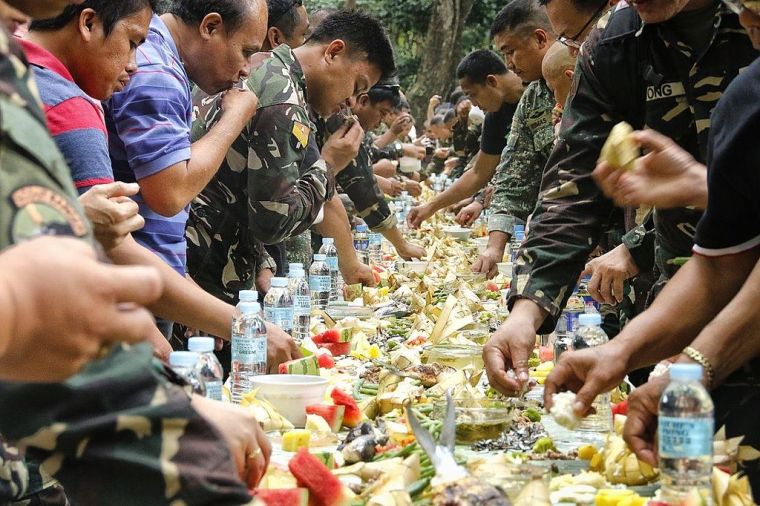 2017 Philippine Army boodle fight – Picture taken by the Philippine Information Agency, created 6 June 2017, https://en.wikipedia.org/wiki/Boodle_fight#/media/File:Boodle_fight.jpg
2017 Philippine Army boodle fight – Picture taken by the Philippine Information Agency, created 6 June 2017, https://en.wikipedia.org/wiki/Boodle_fight#/media/File:Boodle_fight.jpg
There are no set rules about which dishes may be served in a boodle fight. However, it is common to have rice (plain boiled, Java1 or garlic fried) at the middle of the table, with viands like grilled meat (pork, chicken), fish (boneless bangus2 or tilapia3) or seafood (squid), on top of the rice or on the sides of the rice, equitably placed on the banana leaves.
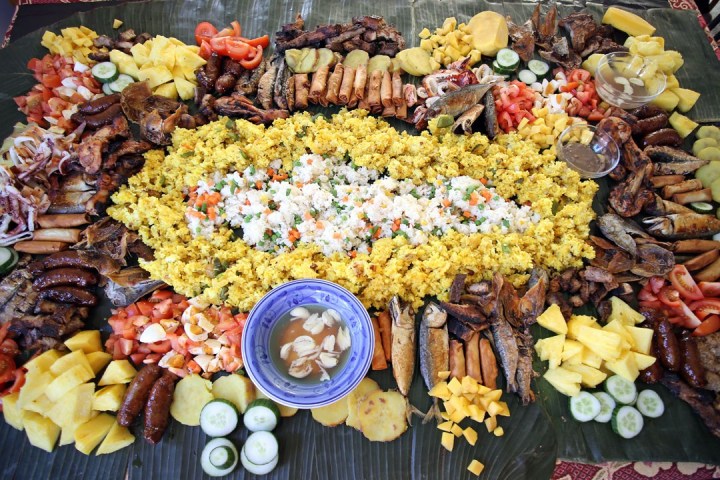 Picture taken by Raymund Macaalay, CC BY-SA 4.0, created 22 February 2015, https://en.wikipedia.org/wiki/Boodle_fight#/media/File:Boodle_Fight_Viands.jpg
Picture taken by Raymund Macaalay, CC BY-SA 4.0, created 22 February 2015, https://en.wikipedia.org/wiki/Boodle_fight#/media/File:Boodle_Fight_Viands.jpg
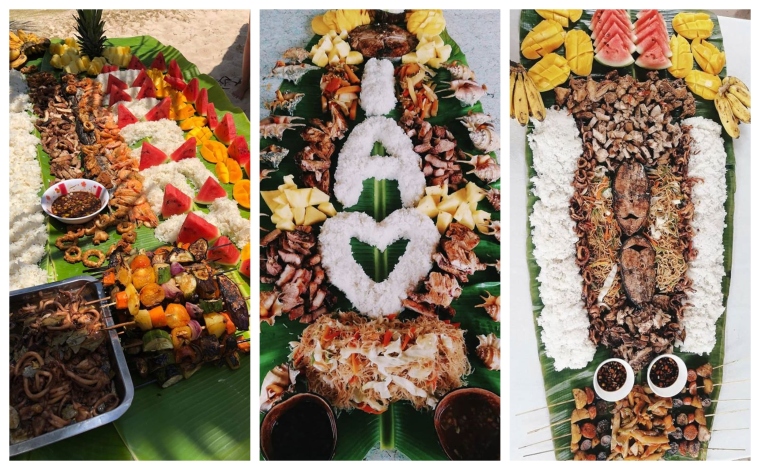 Boodle Fight Styles, Kermit Surf Resort and Restaurant, Siargao, 2019, https://www.facebook.com/pg/kermitsiargao/photos/?ref=page_internal
Boodle Fight Styles, Kermit Surf Resort and Restaurant, Siargao, 2019, https://www.facebook.com/pg/kermitsiargao/photos/?ref=page_internal
There must be a provision for washing one’s hands, even just a jug of water nearby to do so. Aluminum foil or plastic can be placed under the banana leaves to avoid spillage. Small bowls for individual, or shared, sauces, dips and spices must be provided for maximum enjoyment of viands. Paper and wet napkins must be available during a boodle fight.
You must also try all the food on the table. Go to the restrooms, and wash your hands, before starting a boodle fight, since no toilet breaks are allowed.
Breakfast meats such as tocino4, longganisa5 and tapa6, can be served with (fried or salted7) eggs, atchara8, cut tomatoes, and even fruits (e.g., mango, pineapple, banana). Fried dried/fresh fish/seafood can also be served, like tuyo9, danggit10, boneless bangus2, and pusit11.
Lunch and dinner boodle fights consist of charcoal-grilled meat (e.g., chicken or pork), grilled fish and/or squid, scalded (locally called halabos12) or buttered shrimps, steamed crabs and mussels/clams, with spicy soy sauce-calamansi13-garlic-onion dip, along with vegetables (e.g., grilled-skinned eggplant, blanched okra and kangkong14), salted eggs7, fresh tomatoes, atchara8, and bagoong alamang15.
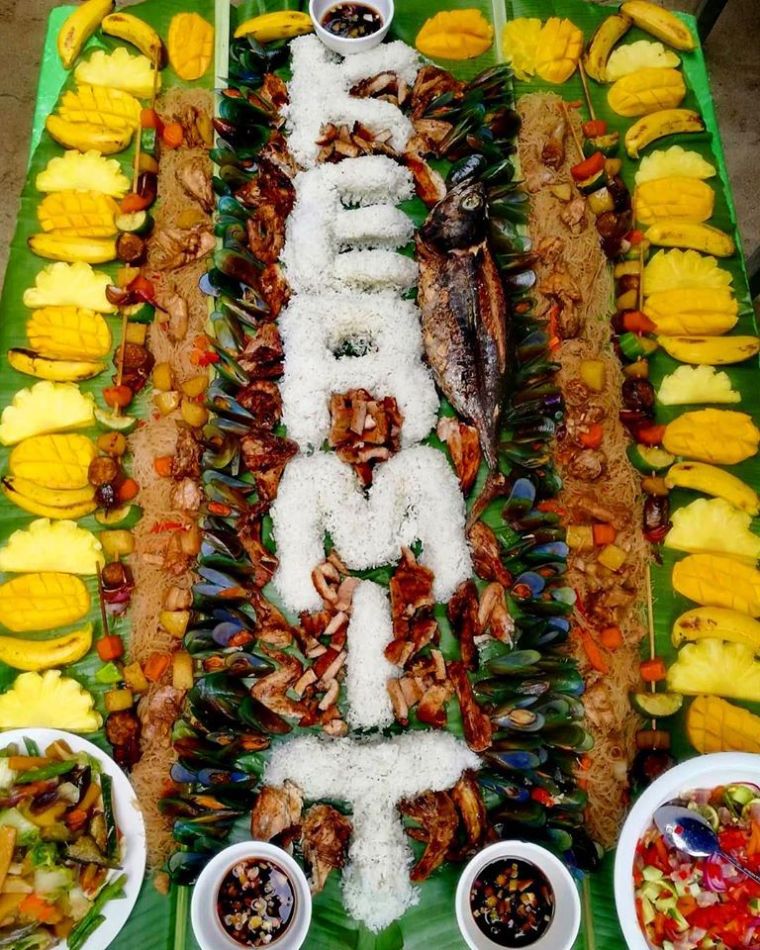
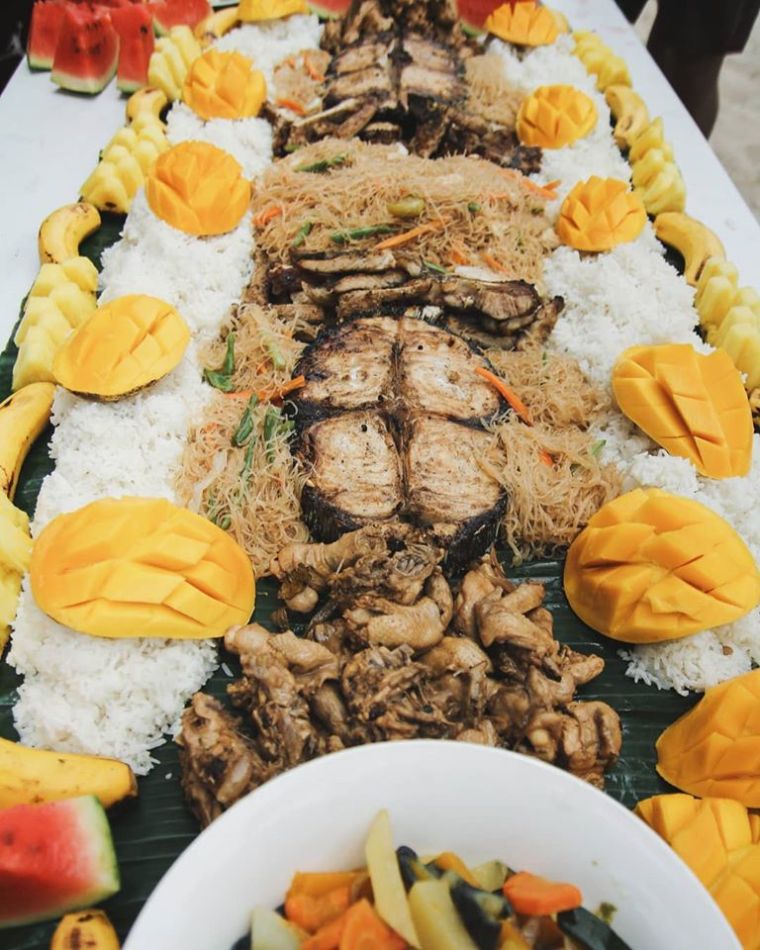
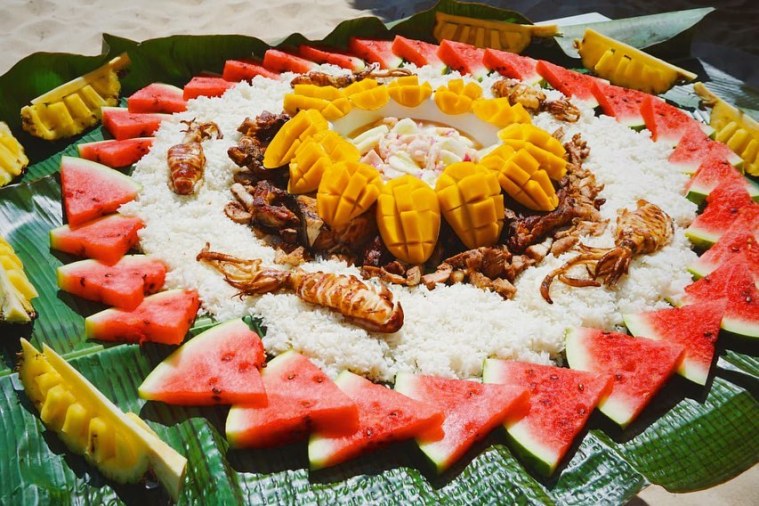
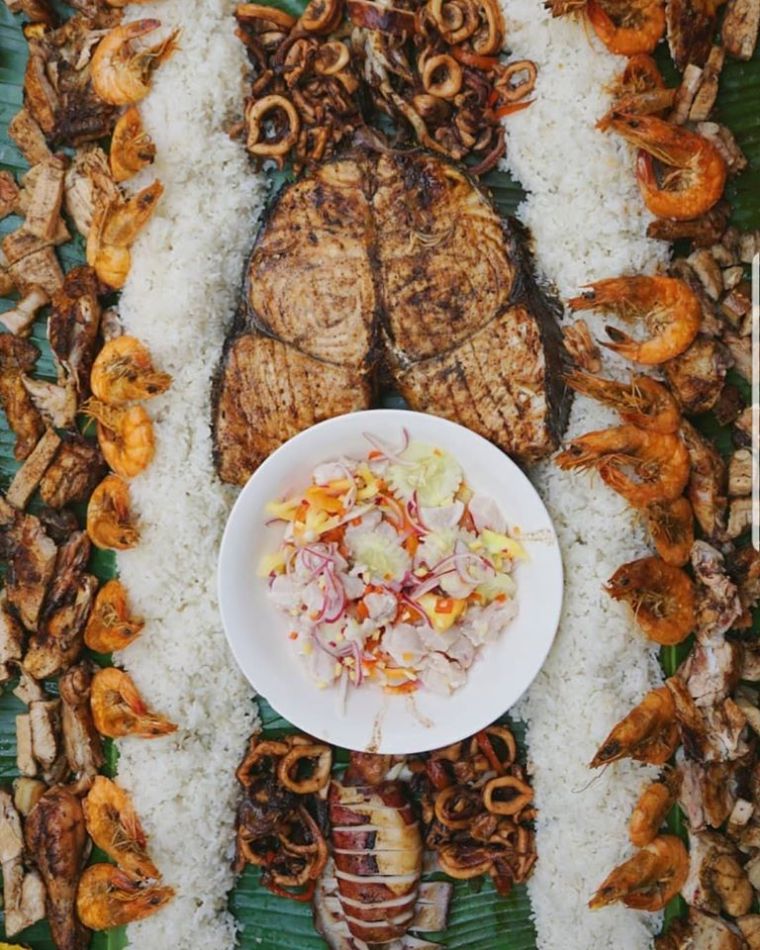
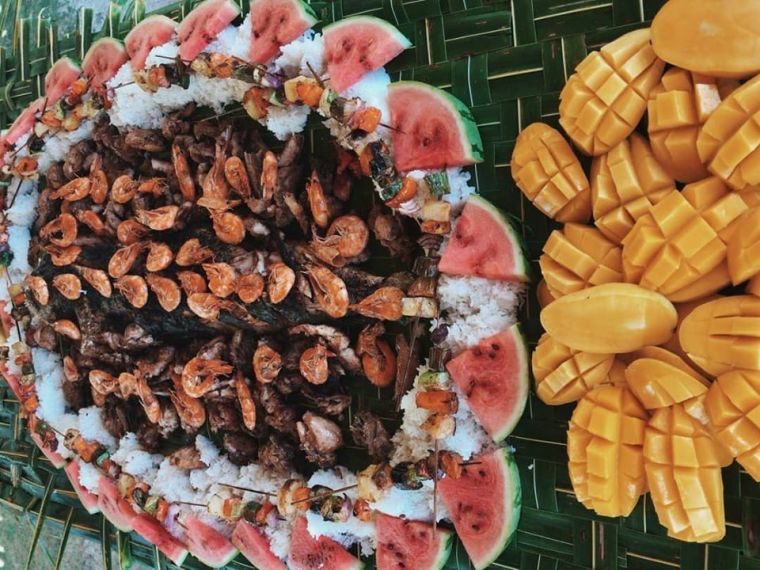 Boodle Fights, Kermit-style, Siargao, taken 2019, https://www.facebook.com/pg/kermitsiargao/photos/?ref=page_internal
Boodle Fights, Kermit-style, Siargao, taken 2019, https://www.facebook.com/pg/kermitsiargao/photos/?ref=page_internal
Pancit16 can also be added as an additional carbohydrate source and as a symbol of long life.
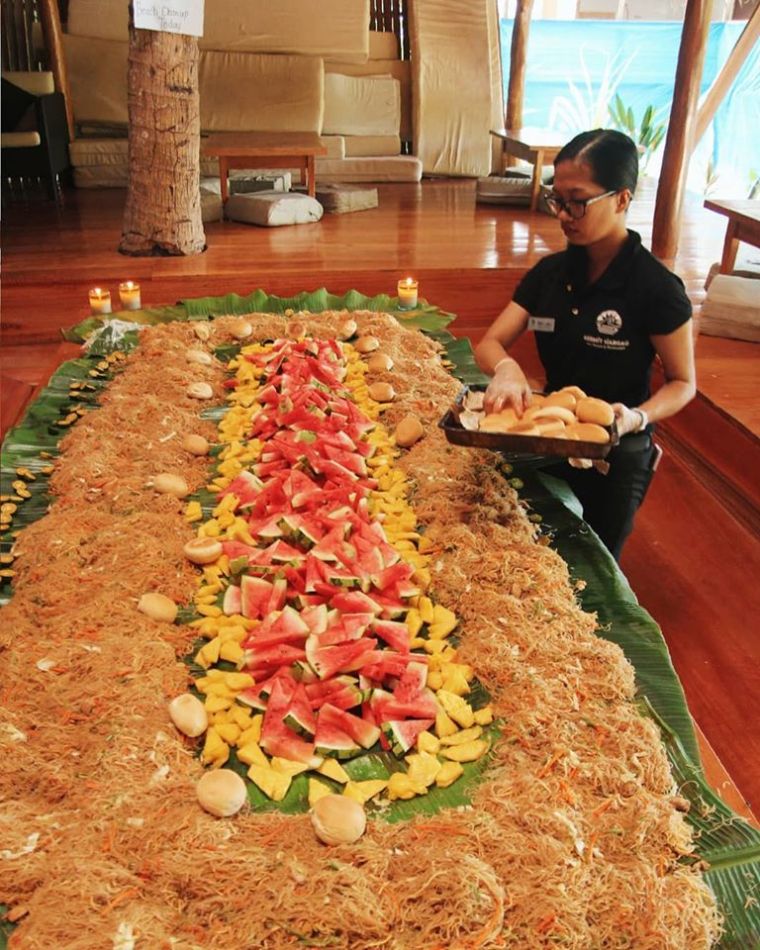 Pancit merienda boodle fight, with pandesal and fresh fruits, Kermit-style, Siargao, taken April 2019, https://www.facebook.com/pg/kermitsiargao/photos/?ref=page_internal
Pancit merienda boodle fight, with pandesal and fresh fruits, Kermit-style, Siargao, taken April 2019, https://www.facebook.com/pg/kermitsiargao/photos/?ref=page_internal
Other items can be added like lumpia17; Adobo18 (chicken, pork or squid); Tortang Talong19; Pinakbet20; beef steak; fried fish; fried chicken; grilled or boiled corn; and even native rice cakes.
Boodle fight is also the common style of eating food during island hopping tours in the different islands of the Philippines, basically consisting of grilled fish, seafood and chicken or pork, along with grilled or ceviche-style vegetables, scalded (halabos12), boiled or steamed shrimps, crab or squid, boiled rice, and assorted fruits in season. Ensaladang Lato21 can also be served.
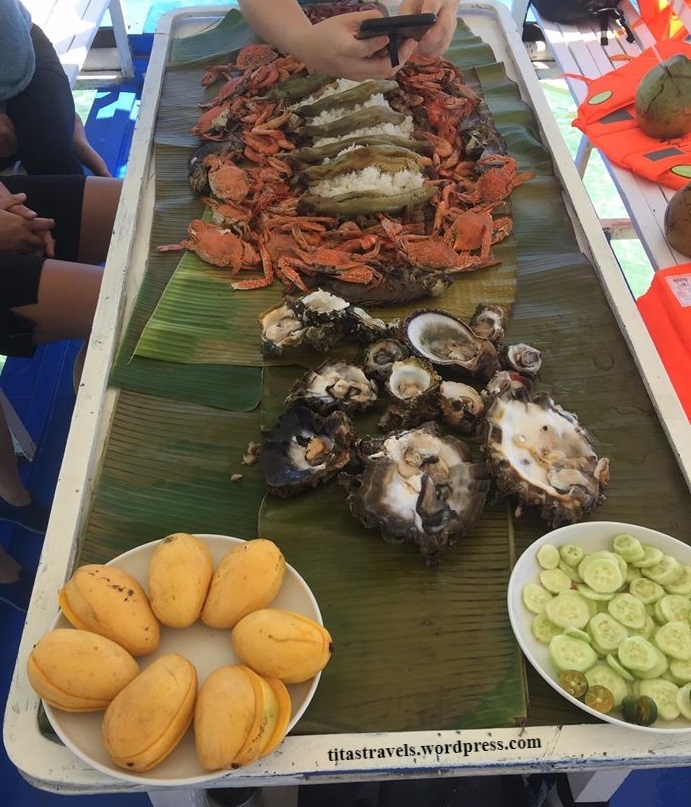 After an exciting dolphin watching experience, our seafood boodle fight for 7 pax, aboard an island hopping boat, Manjuyod Sandbar, Bais City, Negros Oriental, March 2019
After an exciting dolphin watching experience, our seafood boodle fight for 7 pax, aboard an island hopping boat, Manjuyod Sandbar, Bais City, Negros Oriental, March 2019
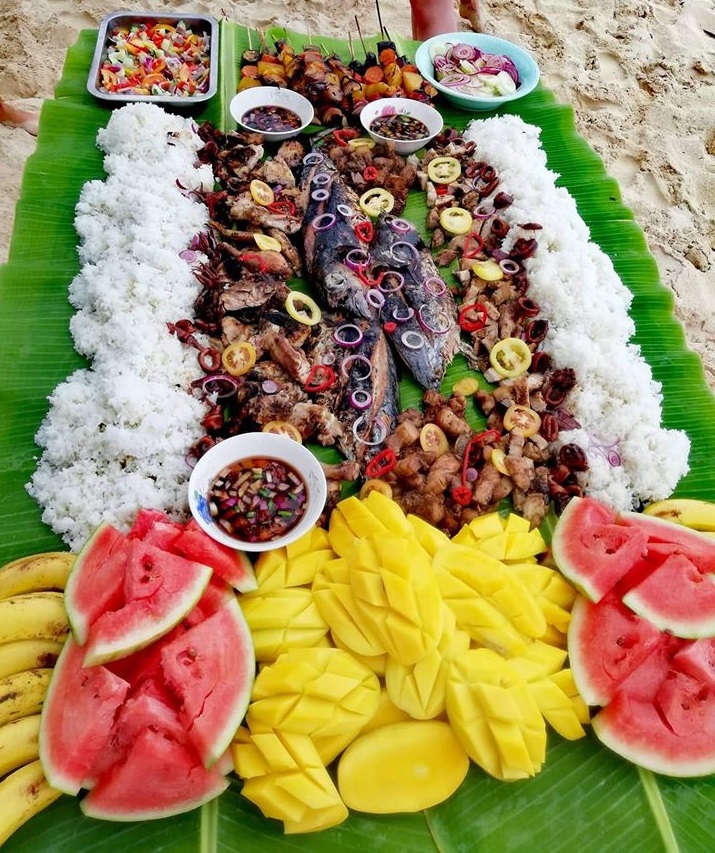
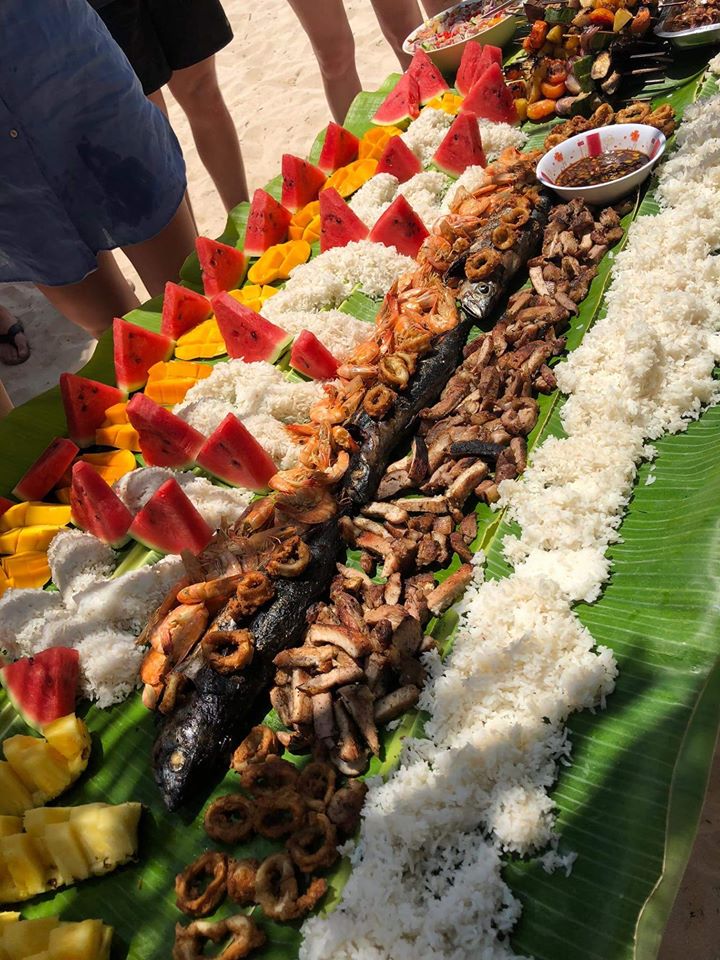
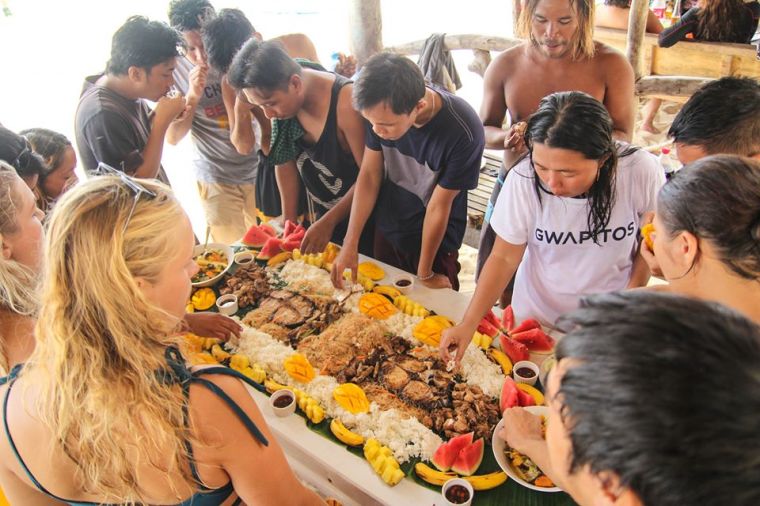 Island Hopping Boodle Fights, Kermit-style, Siargao, taken 2019, https://www.facebook.com/pg/kermitsiargao/photos/?ref=page_internal
Island Hopping Boodle Fights, Kermit-style, Siargao, taken 2019, https://www.facebook.com/pg/kermitsiargao/photos/?ref=page_internal
There are also Filipino restaurants which offer boodle fight selections for a minimum of four persons to comfortably sit around a square table, up to a group of 10 persons, on both sides of a rectangular trestle-like table. A package price is pegged, depending on the number of people in the group. Sometimes, the package includes pitchers of juices or drinks, good for all at the table.
You can check out different websites to locate such restaurants in your vicinity like https://www.wheninmanila.com/10-boodle-fight-restaurants-in-manila/ for those in Manila, and https://www.wheretogo.com.ph/food/best-boodle-fights-restaurants-metro-manila for Metro Manila.
They say you must finish everything prepared on the banana leaves so, dearest Senior Citizens, boodle fight might not be for all of us. Let us fight our own food battles by choosing quality food, in just the right quantity, for us to enjoy. But sometimes, what the heck, dig in!
The information was obtained from the Wikipedia page “Boodle fight”.22
Bottomline, a boodle fight is not fine dining. It is a fun feast for the heavy eaters, families with a great appetite, people who are willing to eat with their bare hands, and foodies! It would be best to schedule a boodle fight after a rigorous activity or exercise. Burp!
This is not a sponsored post.
The pictures in the featured collage-image of this post were taken from https://www.facebook.com/pg/kermitsiargao/photos/?ref=page_internal
Did you find this post informative? I would like to hear your comment/s regarding your boodle fight experience.
See other interesting posts in this category (Foreign Traveler Asks), Smart Travelers (Now You Know and Say, Say, Say), and other categories – SCapades and Pinoy Delights. Happy reading, and I hope that you will appreciate what I shared and some of the featured destinations will be part of your future travel plans!
Do share this post with your Facebook friends, follow me by clicking on the bottom right corner of your device, and do not forget to like this post. Thank you.
– – – – – – – – – – – – – – – – – – – – – – – – – –
The following terms are defined for interested readers, especially those with “Senior-Moments”, not familiar with Filipino terms, and those too busy or lazy to Google such terms:
1Java rice is a bright-yellow-orange colored fried rice which uses turmeric as the main flavoring and coloring, and originated from the Philippines, according to the Wikipedia page “Java Rice”.23 It is made from leftover steamed rice, garlic, shallots, bell pepper, butter and oil, annatto and turmeric powder, soy sauce and salt and pepper to taste. Some recipes do not use turmeric powder; the annatto powder is enough to give its distinct color.
I remember that it was popularized by the Aristocrat restaurant chain which served it with their signature grilled sweet style-chicken and pork barbeque. It also goes well with other grilled Filipino dished like Chicken Inasal24, and cured-meat favorites like tocino4, longganisa5 and beef tapa6.
2Bangus is the Filipino term for milkfish, the sole living species in the family Chanidae which grows to be no more than 1 meter in length. It has an elongated and almost compressed body, with a generally symmetrical and streamlined appearance, one dorsal fin, falcate pectoral fins, and a sizable forked caudal fin. Its body color is olive green, with silvery flanks and dark bordered fins. Its mouth is small and toothless. Information is from the Wikipedia page “Bangus”.25
Bangus is considered the national fish of the Philippines. Dagupan City is known for producing quality bangus. The boneless version is popular to save the trouble of removing (especially the small, finer) bones while eating. It can be fried, smoked, fermented and further processed (bottled, canned or frozen).
3Tilapia is a freshwater fish which inhabits shallow streams, ponds, rivers and lakes in temperate countries. In the Philippines, it is commonly called pla-pla and several species of tilapia are commercially grown in major lakes and rivers like Laguna de Bay, Taal Lake and Lake Buhi. The information was obtained from the Wikipedia page “Tilapia”.26
4Tocino is a Filipino-style cured meat, often sweet, and is usually made of pork, but chicken and beef can also be used. It is fried and served for breakfast, along with fried rice, and even with fried egg. It is traditionally colored red using saltpeter.
5Longganisa, or longaniza, in the Philippines, is a fresh or smoked sausage, made using varying ratios of lean meat (pork, beef, chicken, tuna) and fat, flavored with garlic, black pepper, salt, saltpeter, brown sugar and vinegar, and usually made with a casing and formed into links. It can also be made without casing (skinless). Other ingredients may be added like anise liqueur, chili, paprika, and other spices. It is commonly dyed red, yellow, or orange, using achuete seeds. There are many regional variations of longganisa – dry, garlicky, spicy, or sweet. The information was obtained from the Wikipedia page “Longaniza”.27
6Tapa refers to the thinly sliced, tangy, sweet-salty, Filipino dried beef, which is cured using salt and spices. Chicken, fish, horse meat, mutton, pork, or venison may also be used. It is usually fried, but can also be grilled, then served with garlic fried rice and fried eggs for breakfast.
7 A salted duck egg is a preserved food product made by soaking duck eggs in brine or packing the eggs in damp, salted charcoal. In the Philippines, the eggs are traditionally dyed red to differentiate it with fresh duck eggs. It is used as a topping for bibingka (a rice cake), or mixed with chopped, fresh tomatoes and scallions, onions and fish sauce, as a side salad for fried fish. See a related post: Pinoy Delight: SAVORING SALTED EGGS OF ITLOG NI KUYA
8Achara, atchara, or atsara, is a pickled side dish, or accompaniment of fried or grilled foods, in the Philippines. It is made of grated unripe papaya, carrot and onion slices, julienned garlic, bell pepper strips, along with vinegar, syrup and salt. Raisins may be added.
9Tuyo is the Filipino term for sun-dried, salted dried fish, usually herring, considered a poor man’s fish, but is enjoyed by all classes. It is fried, enjoyed with tomato slices and a spicy vinegar dip, and eaten with plain or fried rice, for breakfast. Filipinos eat champorado (sweet chocolate-flavored rice porridge) with tuyo, for that sweet-salty combination.
Heads up, some people, especially foreigners, do not like the strong scent of this fish while being fried, so be conscious when cooking in closed areas, especially abroad.
10Danggit is a small, thin, sun-dried, salted fish, considered a delicacy in Cebu, in the Visayas (central part of the) Philippines. It is fried till crispy, and just like tuyo, it is enjoyed with tomato slices and a spicy vinegar dip, and eaten with plain or fried rice, for breakfast.
I enjoy eating the small size, about 2 inches, so that it is crispy, not chewy, along with garlic fried rice and atchara8. I definitely eat the whole fish, from head to tail.
It is called rabbitfoot or spinefoot fish in English, according to the Wikipedia page “Daing”.28
11Pusit is the Filipino term for squid, usually cooked as adobo18 or grilled.
12Halabos is an easy Filipino cooking process consisting of fresh, unshelled shrimp, prawn, crab, or other crustaceans cooked in water and salt, allowed to stew in their own juice, and until the color is reddish-pink. Modern versions of the dish commonly add spices (like chilis and garlic) and carbonated soft drinks like Sprite or 7Up, instead of water, for a sweeter sauce. Butter may be added.
It is also spelled hablos, halbos, or halbus. Halabos is a verb meaning “to scald in saltwater” in Filipino.
The information was obtained from the Wikipedia page “Halabos”.29
13Calamansi is a small (about 30-mm in diameter), tangy-sour citrus fruit with a thin, green skin (which turns yellow-orange when ripe), with a yellow/orange pulp. The juice is used in various food and beverages as a major/minor ingredient, seasoning or dipping ingredient.
14Kangkong is a semi-aquatic, tropical vegetable-plant, grown for its leaves and tender shoots. It is also known as swamp cabbage, Chinese convolvulus/spinach/watercress, water morning glory, and river/water spinach. The information was obtained from the Wikipedia page, “Ipomoea aquatica”.30
It is a popular vegetable in Filipino cuisine, used in a variety of dishes like sinigang31 and adobo18.
15Bagoong alamang is the Filipino term for shrimp paste, made from the same Acetes shrimp (locally called alamang) as the Indonesian and Malaysian versions. It is also called aramang, dayok, ginamos and uyap in different Philippine dialects. The information was obtained from the Wikipedia page, “Shrimp paste”.32
The shrimps are marinated for a few days with salt, sold in the wet market, and sautéed with chili (for the spicy variant), or sugar (for the sweet variant), and even bits of pork to make it tastier. It is also used as an ingredient in different Filipino dishes, or as a popular dip. Filipinas love eating green mangoes with it.
16Pancit is the Filipino term for noodles, introduced by the Chinese, and adopted into the local cuisine, with many regional variations. Some versions of this noodle dish are stir-fried, often with sliced meat, shrimps and assorted/chopped vegetables.
17Lumpia is the Filipino term for “spring roll”. It is a savory dish made with a thin crepe pastry skin called “lumpia wrapper” enveloping a mixture of savory fillings, consisting of chopped vegetables (e.g., bamboo shoots, cabbage, carrot, green beans, leeks), or sometimes also minced meat (beef, chicken, pork and shrimp). It is often served as an appetizer, viand, or snack, and could be served deep fried or fresh (unfried). The information was obtained from the Wikipedia page “Lumpia”.33
18Adobo is a Filipino version of the Spanish adobo/adobar, according to Wikipedia page “Adobo”.34 It was originally made by stewing meat (chicken and/or pork) in vinegar and soy sauce, with garlic, salt and bay leaves, sometimes with sliced potatoes. It is sometimes fried after stewing.
19Tortang Talong is the Filipino term for Eggplant Omelette (torta is omelette and talong is eggplant). The long, slender, purple variety of eggplant is grilled (till charred), skinned (but the stalk is retained), mashed flat with a fork, dipped in an egg mixture (plain beaten egg with salt and pepper), and pan-fried till golden brown yet the core remains soft and creamy. It can be eaten as is, with catsup or dipped in soy sauce or vinegar, or served as a side dish to meat dishes. A popular variation is to cook it the same way but stuffed with ground meat, seafood and/or vegetables. The information was obtained from the Wikipedia page “Tortang talong”.35 See a related post: EGGPLANT DISHES OF THE PHILIPPINES
20Pinakbet, pakbet, or pinak bet, is an indigenous Filipino dish made from mixed vegetables (bitter melon, eggplant, okra, string beans, winged beans, tomato, chili peppers), spiced with garlic, ginger and onions. steamed in fish or shrimp sauce, from the northern regions of the Philippines. Meat may be added. The Tagalog version includes squash. The word is the contracted form of the Ilokano (a northern Philippine dialect) word pinakebbet, meaning “shrunk” or “shriveled”. The information was obtained from the Wikipedia page “Pinakbet”.36
21Ensadang Lato is a Filipino seaweed salad made of lato37, diced tomatoes, minced onions, vinegar, ground black pepper, salt, sugar and fish sauce.
22“Boodle fight,” accessed May 13, 2019, https://en.wikipedia.org/wiki/Boodle_fight
23“Java Rice,” accessed May 13, 2019, https://en.wikipedia.org/wiki/Java_Rice
24Chicken Inasal, or simply inasal, is a common chicken dish in the Visayas (the central part of the Philippines). The chicken is marinated in a mixture of calamansi13, coconut vinegar, pepper and annatto, then grilled over hot coals, while basted with the marinade. It is served with rice, calamansi, soy sauce, chicken oil and vinegar. The information was obtained from the Wikipedia page “Chicken inasal”.38
25“Bangus,” accessed May 11, 2018, https://en.wikipedia.org/wiki/Bangus
26“Tilapia,” accessed December 12, 2018, https://en.m.wikipedia.org/wiki/Tilapia
27“Longaniza,” accessed December 12, 2018, https://en.wikipedia.org/wiki/Longaniza
28“Daing,” accessed December 12, 2018, https://en.wikipedia.org/wiki/Daing
29“Halabos,” accessed December 12, 2018, https://en.wikipedia.org/wiki/Halabos
30“Ipomoea aquatica,” accessed April 20, 2018, https://en.wikipedia.org/wiki/Ipomoea_aquatica
31Sinigang is a Tagalog sour-savory soup/stew made of meat/fish, vegetables (like tomatoes, kangkong14, yardlong beans, eggplant, finger-long peppers, okra, radish, taro) and a sour ingredient (e.g., fresh tamarind or powdered tamarind mix, guava, kamias39, calamansi13, santol40 or unripe mango) in the Philippines, according to the Wikipedia page “Sinigang”.41
32“Shrimp paste,” accessed December 12, 2018, https://en.wikipedia.org/wiki/Shrimp_paste
33“Lumpia,” accessed December 12, 2018, https://en.m.wikipedia.org/wiki/Lumpia
34“Adobo,” accessed December 12, 2018, https://en.m.wikipedia.org/wiki/Adobo
35“Tortang talong,” accessed December 12, 2018, https://en.wikipedia.org/wiki/Tortang_talong
36“Pinakbet,” accessed December 12, 2018, https://en.wikipedia.org/wiki/Pinakbet
37Lato is a farmed, grape-like edible seaweed, with lots of green bubbles on its stems, so it is sometimes called sea grapes. Locally, it is also called arosep. Its binomial name is Caulerpa lentillifera, a species of bryopsidale green algae from the coastal regions in the Indo-Pacific. It is soft and succulent, and bursts in your mouth to release a fresh, salty flavor.
There are two kinds: the small circular kind, and the bigger oval-shaped variety. It is bought from the wet market fresh and just needs to be rinsed completely before use.
The information was obtained from the Wikipedia page “Caulerpa lentillifera”.42
38“Chicken inasal,” accessed May 11, 2018, https://en.wikipedia.org/wiki/Chicken_inasal
39Kamias is the Filipino term for Averrhoa bilimbi, the small tropical tree and fruit of the genus Averrhoa, family Oxalidaceae, native to Indonesia, and now cultivated also in the Philippines, Bangladesh, Malaysia, Maldives, Myanmar, Sri Lanka, Zanzibar, Central American, South American and other Southeast Asian countries. It is commonly known as bilimbi, cucumber tree or tree sorrel. The tree is often multitrunked, quickly dividing into ramifications, with alternate, pinnate leaves measuring 30-60 cm in length, with each ovate or oblong leaf with 11-37 leaflets, clustered at branch extremities.
The fruit is ellipsoidal, elongated, measuring 4-10 cm, and sometimes faintly 5-angled. The skin is smooth to slightly bumpy, thin and waxy, turning from light green to yellowish-green when ripe. The flesh is crisp and the juice is sour and extremely acidic. It is a popular souring, flavoring or seasoning ingredient for the Filipino dish called sinigang31.
Infanticipating Filipino women who crave for something sour sometimes eat the fruit raw, dipped in rock salt.
The information was obtained from the Wikipedia page “Averrhoa bilimbi”.43
40Santol, cotton fruit, or sandoricum koetjape, is a seasonal, tropical fruit grown in Southeast Asia. The round, yellow or red fruit, has a thin peel or thick rind, depending on the variety. It has a slightly fuzzy texture like peaches, with a reddish tinge. The central pulp near the seeds may be sweet or sour, and contains inedible brown seeds. In some varieties, the outer rind is thicker and is the main edible portion, with a mild peachy flavor combined with some of the taste and the pulpy texture of apples. In others, the outer rind is thinner and harder, and the inner whitish pulp around the seeds is eaten.
The pulp is eaten raw and plain, or with salt. Some add spices. It is also cooked and candied, or made into marmalade. The partly ripe sour fruits in the Philippines are used as a souring agent in sour broth dishes like sinigang31. Filipinos also grate the rind and cook it in coconut milk with bits of pork and hot pepper, served as Sinantolan in Southern Luzon.
The information was obtained from the Wikipedia page “Sandoricum koetjape”.44
41“Sinigang,” accessed May 11, 2018, https://en.wikipedia.org/wiki/Sinigang
42“Caulerpa lentillifera,” accessed May 11, 2018, https://en.wikipedia.org/wiki/Caulerpa_lentillifera
43“Averrhoa bilimbi,” accessed May 11, 2018, https://en.wikipedia.org/wiki/Averrhoa_bilimbi
44“Sandoricum koetjape,” accessed May 11, 2018, https://en.wikipedia.org/wiki/Sandoricum_koetjape


One thought on “Foreign Seniors Ask: WHAT IS BOODLE FIGHT?”